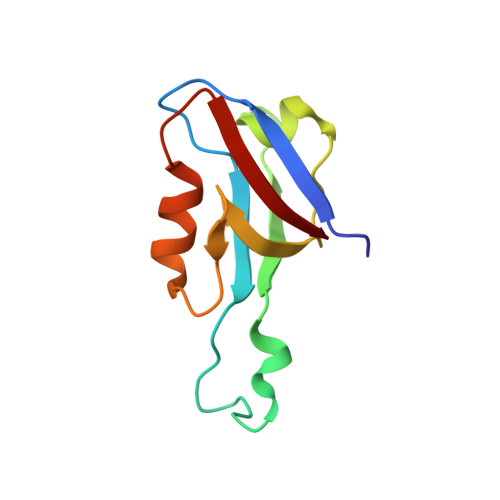Scribble co-operatively binds multiple alpha1D-adrenergic receptor C-terminal PDZ ligands.
Janezic, E.M., Harris, D.A., Dinh, D., Lee, K.S., Stewart, A., Hinds, T.R., Hsu, P.L., Zheng, N., Hague, C.(2019) Sci Rep 9: 14073-14073
- PubMed: 31575922
- DOI: https://doi.org/10.1038/s41598-019-50671-6
- Primary Citation of Related Structures:
6EEY - PubMed Abstract:
Many G protein-coupled receptors (GPCRs) are organized as dynamic macromolecular complexes in human cells. Unraveling the structural determinants of unique GPCR complexes may identify unique protein:protein interfaces to be exploited for drug development. We previously reported α 1D -adrenergic receptors (α 1D -ARs) - key regulators of cardiovascular and central nervous system function - form homodimeric, modular PDZ protein complexes with cell-type specificity. Towards mapping α 1D -AR complex architecture, biolayer interferometry (BLI) revealed the α 1D -AR C-terminal PDZ ligand selectively binds the PDZ protein scribble (SCRIB) with >8x higher affinity than known interactors syntrophin, CASK and DLG1. Complementary in situ and in vitro assays revealed SCRIB PDZ domains 1 and 4 to be high affinity α 1D -AR PDZ ligand interaction sites. SNAP-GST pull-down assays demonstrate SCRIB binds multiple α 1D -AR PDZ ligands via a co-operative mechanism. Structure-function analyses pinpoint R1110 PDZ4 as a unique, critical residue dictating SCRIB:α 1D -AR binding specificity. The crystal structure of SCRIB PDZ4 R1110G predicts spatial shifts in the SCRIB PDZ4 carboxylate binding loop dictate α 1D -AR binding specificity. Thus, the findings herein identify SCRIB PDZ domains 1 and 4 as high affinity α 1D -AR interaction sites, and potential drug targets to treat diseases associated with aberrant α 1D -AR signaling.
Organizational Affiliation:
Department of Pharmacology, School of Medicine, University of Washington, 1959 NE Pacific Street, Seattle, WA, 98195, USA.














